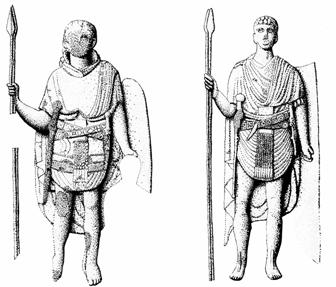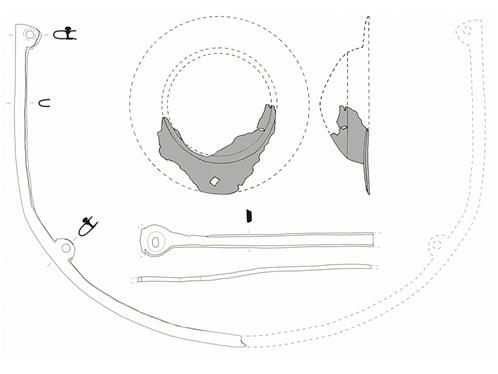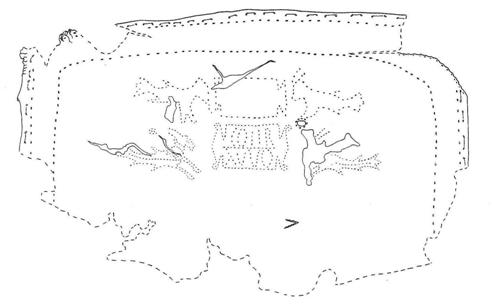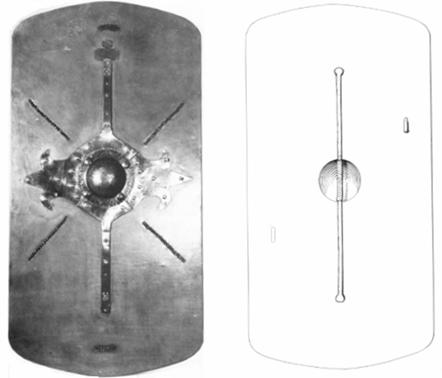|
|
| |
| Shield shapes of the auxiliary
soldier. (Scutum forma milites auxiliaribus) |
Peronis
(Adrian Wink)
|
|
| |
There has been a lot of discussion by our group
members recently with regard to shield shapes attested for
auxiliary soldiers. I have examined evidence for both infantry
and cavalry types and I would like to share the results of
these discussions and present the evidence for here for further
discussion.
We have quite a variety of ways to identify
the different shield shapes used by auxiliary soldiers from
the first and second centuries. These include the remains
of leather shield covers (Tegimen) and copper-alloy
shield edging finds. Although rare, we also have the remains
of the shield boards themselves. However, our main source
of reference is once again sculptural so I shall begin with
the sculptural evidence.
Propaganda
reliefs (The 'Columns' and Adamklissi metopes)
Propaganda relief such as the Columns of Trajan and Marcus
clearly show the auxiliary soldiers both infantry and cavalry
being almost universally equipped with the long flat oval
body shield. That said there is one unusual depiction on Trajan's
Column of an auxiliary soldier equipped with a curved rectangular
shield. Whether this was an honest mistake by the artist,
or whether it actually depicts a soldier of one of the citizen
'Voluntariorum cR' cohorts will be discussed later.
We also see on the Marcus Column that by the time of the Marcomannic
Wars it appears some legionary soldiers are also equipped
with flat oval shields.
The Adamklissi metopes show the auxiliary infantry
equipped with large flat oval shields. (Metope 14) Conversely,
the cavalry are shown with an assortment of hexagonal, rectangular
and long parallel-sided oval shields.
Grave stele
Most infantry soldiers' grave stele which
show the soldier with his shield are of soldiers with a legionary
background. The most notable to the Society are the gravestones
of the soldiers of LEG XIIII GMV which show the actual blazon
on the face of the shield. (CIL 13, 06901 -Gnaeus Musius-
Aquilifer). Most of the depicted legionary shields are
of either curved-oval or curved-rectangular construction.
|
| |
The grave stele of 'Annaius
Daverzus' an auxiliary soldier of Cohors IIII Delmatarum
(CIL 13, 07507) shows a shield that is large, rectangular and
completely flat with a horizontal handgrip. The bottom edge
of the shield is uncertain, as the carving has suffered damage
at some point and has been restored in recent times. However,
it is reasonable to assume the continual symmetry of a rectangle.
It is a very unusual shape in respect of most modern accepted
conceptions of an auxiliary shield. The stele of Firmus of Cohors
Raetorum (CIL 13, 07684) shows the more typically depicted long
oval body shield also with a horizontal handgrip. |
 |
Seen on many cavalry tombstones of the first
century are hexagonal or pseudo-hexagonal (curve-edged centre
section) shields. Probably Celto-Germanic in origin, they do
not appear on sculpture of Roman infantry soldiers. A very good
example is the gravestone of 'Imerix' a Batavian trooper
of the Ala Hispanorum (ILJug-02, 00843 = AE 1971, 00299). Although
the hexagonal shield is not represented on Roman soldiers on
the Columns, It does however appear as part of trophy items
of equipment at the base. It is also seen on the Arch of Orange
again showing its origins and ethnicity.
Shield components (umbones and edging)
Shield shapes can be reconstructed from the remains of copper-alloy
shield edging fragments if large enough. For example a ninety-degree
bend would generally be accepted as being part of a rectangular
shield board. There are finds of parallel-sided oval shields
which have been discovered in a Batavian river deposition at
Kessel/Lith in the Netherlands alongside both native Germanic
and Roman military equipment. (Nico Roymans- Ethnic Identity
and Imperial Power: The Batavians in the Early Roman Empire
- Amsterdam University Press 2005). The fragment consists
of the lower straight portion and the first half of the curved
portion. From this we can determine that the shield board was
approximately 7-9mm thick with parallel sides and hemispherical
ends. It is of a type that can be attested to Batavian use which
I intend to reconstruct as part of our display. |
|
| |

Shield components from the Batavian
deposit at Kessel.
|
|
| |
Leather shield covers (Tegimen)
Leather shield covers can tell us a great deal about the original
shield shapes and sizes. Even in some cases, which unit were
using certain types of shield. Leather covers have been preserved
as partial remains large enough to allow the calculation of
the board size. (C. van Driel-Murray 1999). From Valkenburg
(NL) we have the remains of a pointed oval and a parallel-sided
oval shield cover, along with remains of rectangular covers.
One notable example from Roomberg (NL)
belonging to a soldier of Cohors XV Voluntariorum cR (pf) is
particularly interesting in that it is a cover for a rectangular
shield with a board wide enough to have been curved in the manner
of the legionary scutum (contrary to Bishop and Coulston 'The
study of Roman military equipment II p255).
The estimated size for the actual shield board (according to
van Driel-Murray) would be in the region of 75cm wide - which
would suggest that the board would have been curved to give
a face of around 62cm. Given that the owner of this cover was
from an auxiliary cohort (not of provincials, but of Citizens)
raises the question - "Following the Pannonian revolt and the
Varian disaster, (6-9AD) were the Voluntariorum cR, Campestris
cR and Ingenuorum cR cohorts raised by Augustus equipped the
same as the legionary soldiers"?
At this time the Emperor was certainly
in need of replacement heavy infantry units. The levies made
on the Citizens were considerable. Augustus' will made certain
that the Citizen volunteer cohorts were paid the same as their
legionary counterparts. They were also commanded by a Tribune
as opposed to the Prefect of the provincial cohorts. Again,
from the Roomberg site, we also have the remains of a pilum
shaft from the 'Corbulo ditch' also dated to the same period
as the shield cover (197-200AD). This would suggest that the
Voluntariorum cR cohorts were indeed equipped the same as the
legions, which brings us back to the unusual depiction on Trajan's
Column of the auxiliary with the curved scutum.
Could the soldier depicted be from a 'cohors Scutata'?
Doubtful for two reasons. 1. The two attested 'scutata'
units Cohors II Hispanorum Cyrenaica scutata equitata
and Cohors I Lusitanorum Cyrenaica scutata equitata were
both part-mounted. It seems unlikely that a heavily curved scutum
would be carried as a cavalry shield, particularly one this
large although the shield shape may have varied within the unit.
2. The fact that the units were not raised from Citizen volunteers.
|
| |
 Shield cover of COH XV Voluntariorum
cR - Roomberg (NL)
Shield cover of COH XV Voluntariorum
cR - Roomberg (NL) |
|
|
| |
Shield boards
The only surviving example of an auxiliary shield
board of the first century comes from Doncaster or Danvm. (Published
by Paul C. Buckland - Dept of Archaeology and Prehistory University
of Sheffield 1986). The shield was excavated in 1971 beneath the
rampart of the 2nd century fort at Danum (Doncaster) Paul Buckland
sums it up in his opening paragraph on the shield:
"Whilst the majority of the objects found
on Roman sites of the region can be matched by many similar pieces
from elsewhere in Britain, the remains of the shield from Doncaster
are so far unique in the Province and therefore merit fuller discussion."
Very careful excavation and post excavation research
revealed the shield to be made of 3 -ply wood 10mm thick. The outer
horizontal layers of the shield are alder whilst the transverse grain
inner vertical core is oak. The shield was "flat and rectangular with
rounded ends, being 125cm long by 64cm wide; the shallow segmental
boss lying 65cm above the base of the board). The shield did not have
a metal edge to it. The boss was of iron and a simple round dome and
flange.
There is some evidence for bronze sheeting applied
to the shield in such a way as to back the boss and create a decorative
section reinforcing the spine of the shield and across its width.
Buckland states "many of the minute fragments of bronze sheet found
had curved edges and it is possible that the whole had once been decorated
with a curvilinear pattern in the Celtic style"
The inner and outer surfaces of the shield were faced with leather
or rawhide (found from chemical analysis). An iron ferrule on the
inside perhaps held a leather carrying strap to swing the shield over
the shoulder when not in use. The shield has a vertical handgrip of
iron and is similar to another vertical iron grip from Newstead (Trimontium).
Upon this evidence Buckland suggests that it may be a cavalry shield.
|
| |
 Reconstruction of the Doncaster shield board
Reconstruction of the Doncaster shield board
|
|
| |
So, to conclude, what evidence of variation do we have for the auxiliaries
in terms of the shield shapes of the first and second centuries? I
have summarised the information into two tables. *I have included
the Doncaster shield in with the infantry shields even though it had
a vertical grip. I have made and used reconstructions of this shield,
(The Vicus' auxiliaries use this design) and the vertical grip
does actually increase its functionality in combat. Because the boss
is offset, it balances beautifully, its vertical grip is however not
so suited to drilling, but it is said that "Absence of evidence
is not evidence of absence". |
For cavalry use:
| Type 1. |
Hexagonal/pseudo-hexagonal |
Cavalry tombstones,
Adamklissi metopes |
| Type 2a. |
Large oval (flat)
Shield cover, |
The Columns, tombstones |
| Type 3. |
Large oval curved
|
Adamklissi metopes |
| Type
4a |
Flat
rectangular |
Doncaster,
Adamklissi metopes, tombstones |
For infantry use:
| Type 5. |
Parallel-sided
oval |
Shield cover, bronze/brass
edging fragments |
|
Type 6.
|
Curved
rectangular |
Shield
cover, The Columns |
| Type 2b. |
Large oval (flat)
Shield cover, |
The Columns, Adamklissi |
| Type
4b |
Flat
rectangular Tombstones, |
possibly
Doncaster* |
| |
From the evidence presented above it would appear that six distinctively
different shapes are seen in use by the auxiliary troops, (omitting
the small 'caetra' of the Iberian slingers and the 'parma'
of the standard bearers) and these are presented here for further
discussion. It would seem that the equipment used by the auxiliaries
be they infantry or cavalry is far more varied that that of the
legions. Tacitus himself, having described the legions then goes
on to say that he will not describe the auxilia because the auxilia
present such complexity and variety that he cannot afford to devote
the necessary space to the subject.
Bibliography
Tacitus - "The Histories" (book IV) Penguin edition.
Bishop M.C. and Coulston J.C. "Roman Military Equipment from the
Punic Wars to the Fall of Rome" 2005
Buckland. Paul C - Roman South Yorkshire: A Source Book. Dept
of Archaeology and Prehistory University of Sheffield 1986
Driel-Murray C. van " A shield cover of Cohors XV Voluntariorum
cR" 1999 Goldsworthy .A. "The Complete Roman Army".
Robinson H. Russell - "The Armour of imperial Rome"' - Lionel Leventhal
publishers Ltd 1975
Roymans Nico "Ethnic identity and imperial power"' - Batavians in
the early Roman Empire - Amsterdam University Press, Netherlands
2005.
|
|

